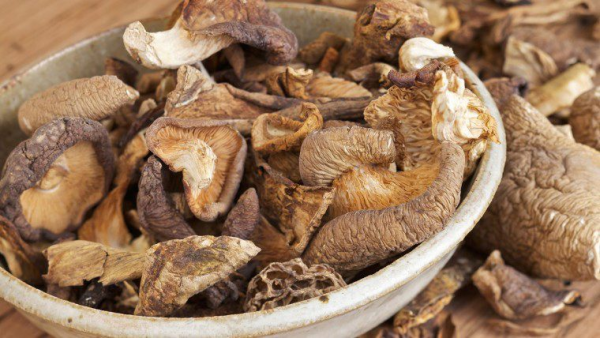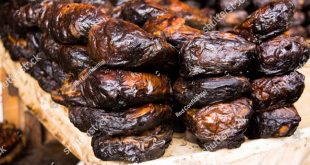
Europe is the largest market for dried mushrooms and fungi in the world, representing around 30% of total world imports in value. Large importing markets such as Germany, France, Italy and Poland offer opportunities for developing country exporters. Opportunities can be found in premium priced wild mushrooms such as wild porcini, chanterelles and truffles, or in exotic mushrooms with health benefits such as shiitake, maitake, cordyceps or reishi mushrooms.
Dried mushroom is the product obtained from fresh edible and cleaned mushroom which is dried whole or has been trimmed to the desired styles and dried. Fresh mushrooms used for drying found on the European market can be cultivated, but a large share of the market is made up of wild dried mushrooms which are collected from their natural environment before drying.

Dried mushrooms are not intended for immediate consumption but as an ingredient after rehydration. They are mainly used in home cooking (e.g. in soups, risottos), as ingredient in dehydrated meals and spices, and as ingredient in healthy food and pharmacy products.
Dried mushrooms of the genus ‘Agaricus’, whole, cut, sliced, broken or in powder, but not further prepared known also as dried button mushrooms, champignon mushroom or chestnut mushrooms; Dried wood ears ‘Auricularia spp.’, whole, cut, sliced, broken or in powder, but not further prepared; Dried jelly fungi ‘Tremella spp.’, whole, cut, sliced, broken or in powder, but not further prepared; Other dried mushrooms and truffles, whole, cut, sliced, broken or in powder, but not further prepared

Product specification

Quality
There is no specific European Union standard defining specific dried mushroom criteria so the applicable standard used in practice is the Codex Alimentarius Standard for Dried Edible Fungi.
The basic quality requirements for dried mushrooms are the following: Absence of insect damage; Absence of foreign bodies; Moisture content (max. 12% for dried mushrooms, 13% for dried shiitake mushrooms and 6% for freeze dried mushrooms); Sizing (different for every type of dried mushrooms); Styles (whole, whole caps without stems or cut into different shapes); Quality class (defined by uniformity and tolerances)
Labeling
The following labeling is used in the trade of dried mushrooms:
The name of the product should be declared in the way that the common and scientific name of the fungus is used. However, terms ‘fungus’ and ‘fungi’ may be replaced by terms used in the destination country.
The type of product: ‘dried fungi/mushroom’ or ‘freeze-dried fungi/mushroom’.
Information about nuts should specify if they are shelled or in shell.
The style: ‘whole’, ‘caps’ or ‘sliced’. In the case of dried jelly mushrooms another styles description can be used such as ‘cluster’, ‘single’, ‘strip’ or ‘square’.
It is common that besides grading, specifications include the production/collection year and variety.
Information for bulk packaging has to be given either on the packaging or in accompanying documents. Bulk packaging labeling must contain the following information: name of the product; ‘lot identification; name and address of the manufacturer, packer, distributor or importer; storage instructions.
However, lot identification, and the name and address of the manufacturer, packer, distributor or importer may be replaced by an identification mark.
In the case of retail packaging, product labeling must be in compliance with the European Union Regulation on food Information to consumers. This regulation defines more clearly nutrition labeling, origin labeling, allergen labeling and legibility (minimum font size for mandatory information). This regulation came into effect on 13 December 2014 but the obligation to provide nutrition information applies from 13 December 2016.
Packaging
There is no general rule for export packaging, but dried mushrooms are usually put in plastic bags inside cartons.
Within Europe, the standard bulk package differs depending on the type of mushrooms. For common types, such as agaricus, bulk packaging can be up to 20 kilograms but other more expensive types like truffles can be packed in much smaller packaging such as 500 g vacuum plastic bags, or even smaller, such as in 100 g glass jars.
The selected packaging size should be such that the dimensions are conformed to the conventional pallet sizes (800×1200 mm and 1000×1200 mm).
Retail packaging includes plastic bags, plastic containers, paper bags, foil bags and glass jars.
Tips
For detailed good hygiene practice please refer to the Codex Alimentarius Code of Hygienic Practice for Dehydrated Fruits and Vegetables including Edible Fungi.
Invest in drying technology and knowledge transfer. Every type of dried mushrooms requires a specific approach with regard to drying technology.
More information on requirements for dried mushrooms can be found further on in this factsheet.
Which European markets offer opportunities for exporters of dried mushrooms?
Germany, France, the Netherlands and Italy offer the best opportunities for exports of dried mushrooms. In addition, markets opportunities can be found in the growing markets of Latvia, Lithuania, Central Europe and Eastern Europe. The products in rising demand are Far East types of mushrooms, truffles and wild collected dried mushrooms.
Imports
Slight decrease in import volume for dried mushrooms in Europe
Although in 2015 the import volume of dried mushrooms decreased compared to 2014, the outlook for import of dried mushrooms in Europe is positive. In 2015 there was a slight decrease because Chinese exporters of dried mushrooms exported significant quantities to neighboring countries and to the USA because they got better prices compared to the European market.
It is likely that imports will stabilize in 2016 but in the long term it is expected that imports will increase. This import trend will be driven by healthy benefits of dried mushrooms especially for some exotic types such as shiitake or reship.
Total European imports of dried mushrooms grew by 4.4% in value, reaching €147 million in 2015. Import in quantity decreased by 1% reaching 10.5 thousand tonnes in 2015. The significantly faster growth in value than in volume is influenced by the increase in dried market prices from Chinese suppliers.
Germany, France, the Netherlands and Italy the largest importers
The European market for dried mushrooms is fragmented, with no single country dominating the import market. Germany is the largest importer of dried mushrooms, importing 2.3 thousand tonnes in 2015, followed by France, the Netherlands, Italy and the United Kingdom.
Central European countries, eastern European countries and Baltic countries are expected to increase imports of dried mushrooms more than Western Europe. Within Europe, the countries with the highest annual import growth rate of dried mushrooms in the last five years were Estonia (76%), Lithuania (31%), Slovenia (25%), Poland (21%) and Bulgaria (20%).
China and India leading developing country suppliers of dried mushrooms to Europe
Almost 40% of all European imports in terms of value are from China, dominated by dried shiitake mushrooms. India is the second European external supplier of dried mushrooms, mainly exporting dried button mushrooms to European markets.
In the range of the first 20 European suppliers of dried mushrooms the highest annual import growth in the last years was recorded from Poland (33%), Canada (30%), the Russian Federation (19%) and Slovenia (40%).
The major intra-European imports involve both re-exports (e.g. from the Netherlands), as well as a country’s own production (e.g. dried porcini collected in Italy or dried wild Polish Borowiki mushrooms).
Main opportunities in shiitake mushrooms, truffles and wild collected dried mushrooms
The most imported types of mushroom in Europe are Chinese shiitake mushrooms, different types of Far East dried mushrooms, truffles, oyster mushrooms and wild mushrooms, such as porcini, chanterelles or morchella mushrooms. Together these account for 77% of European imports. The share of dried ‘Agaricus’ mushrooms was 18%, ‘Weed Ears’ 4% and ‘Jelly Fungi’ 0.75%.
For developing country suppliers opportunities can be found in exports of premium priced wild mushrooms such as truffles, or in exotic mushrooms with health benefits, such as shiitake, maitake, cordyceps and reishi mushrooms.
Tips
Identify who the biggest importers of your product are in selected large or fast-growing markets. You can start with an internet search or read more about supply chains in Europe in our study on market channels and segments for edible Nuts and dried fruit.
Besides aiming to export to the largest European importers, consider countries that are seeing growth in imports, such as the Baltic countries, and Central and eastern European countries.
Learn from developing country exporters who are increasing their share of the European market, such as Canada, India, Russian Federation, Bosnia and Macedonia.
Exports
Growth in export volume faster than in value
In terms of value, European exports (including trade within Europe) of dried mushrooms have grown annually since 2011 by 15.2% and reached €122 million in 2015. In quantity, exports grew by 23.2% and reached 13 thousand million tonnes in the same period. Faster growth in value than in volume is influenced by an increase of prices in the last year due to strong Chinese competition.
Around 92% of all European exports are intra-European exports.
The export market is very concentrated and the Netherlands alone accounts for more than 50% of total exports. However, Dutch exports mainly consist of re-exports of imported products.
Among all European exporters in last five years, the highest export growth was in Latvia (175%), Croatia (90%), United Kingdom (46%) and Poland (65%). However all mentioned countries have very small import volumes except Poland.
Switzerland most important export destination
The main external export destination in 2015 was Switzerland, followed by the United States, Canada and Turkey.
In the range of the largest European export destinations, the highest increase of export from the European Union in the last five years was to Bosnia and Herzegovina, Argentina and Serbia.
It is interesting that dried chaga mushrooms powder is increasingly exported from Europe to China, Vietnam and Hong Kong. In those countries European chaga powder is used in traditional medicine. Chaga powder is especially valued if it is imported from northern European countries due to belief in special health benefits of chaga which is grown under the influence of Polar Lights.
Besides targeting your export to the European Union, you can learn from European exporters and find opportunities in other growing market for dried mushrooms as United States, Switzerland or Turkey.
Learn more about your competitors in our study about competition in edible nuts and dried fruit.
Production
Production of dried mushrooms in Europe stabilising
Although production value is showing a decrease in the last years’ production, production volume is actually stable and even increasing.
France is the largest producer of dried mushrooms in Europe (37 thousand tonnes) followed by Italy (35 thousand tonnes) and Germany (33 thousand tonnes). However, official European statistics included in this data not only processing and drying of fresh mushrooms but also packing of imported bulk mushrooms into retail packaging.
With regard to production of fresh mushrooms, the largest European producer is Poland which mainly produces fresh white button mushrooms which are exported fresh or used for canning. Only a small proportion of Polish white button mushrooms are dried as they are not so popular among consumers compared to wild mushrooms which are more aromatic. However Polish producers dry forest mushrooms of the species ‘Boletus’ under the local brand name ‘Borowiki’.
Production companies (drying, collecting and packing companies) include Arcadie (France), Sabarot (France), Inaudi (Italy), Filotei Group (Italy), Nasza Chata (Poland), Jampol (Poland) and Biofungi (Germany and Switzerland).
The largest producing companies often also sell imported dried mushrooms. Consider contacting producing companies as they thus are potential customers.
Consumption
Consumption of dried mushrooms is increasing
In terms of value, European apparent consumption increased from €158 million in 2010 to €177 million in 2014. The largest consuming countries are France, Italy and Germany.
Apparent consumption of dried mushrooms is showing an increase, especially in the last four years. Stimulated by a continuous trend towards healthier lifestyles, it is expected that European consumers will increasingly appreciate dried mushrooms as a source of vegetable protein.
The most consumed types of dried European mushrooms in Europe are: truffles, porcini, morels, chanterelles and trumpets. The most consumed type of non-European dried type of mushroom is shiitake (originally of Japanese origin bust now more imported from China).
In targeting your markets, make a distinction between countries that import dried mushrooms for their own consumption and countries that import products and re-export them to other countries. In the first category, more attention should be paid to developments in the retail sector and local consumption trends.
You can look for national trends regarding mushrooms and fungi collection on the national web pages which can be accessed through the European Mycological Association website.
Which trends offer opportunities on the European market for dried mushrooms?
The main general trends which offer opportunities for developing country exporters are: consumer demand for vegan, gluten-free and natural food; food safety certification supported by frequent laboratory tests; corporate social responsibility (CSR) standards that can also be a great advantage to European markets suppliers.
Specific trends for dried mushrooms:
Several types of mushrooms are considered ‘superfood’ specifically due to benefits involving anti-cancer effects. The top two types of dried mushrooms marketed in the ‘superfood’ category are organic shiitake and reishi mushrooms. Chaga mushroom powder is also popular and is now exported from Estonia (Berry Group).
Dried mushrooms are increasingly used in ‘ready to make’ products, for example packed risotto with dried mushrooms (such as Italian Riso Galo) or in dehydrated mushroom soup (e.g. Knorr or the brand Maggi, owned by Nestlé).
Producers are introducing on the market common mushrooms enriched with microelements such as selenium, magnesium and vitamin D, via compost. However this is in trial phase as consumers are still sceptic.
The ready meals and dehydrated soup industries are major industrial consumers of dried mushrooms. The European ready meals market is expected to surpass €40 billion by the end of 2016. The consumption of dried soups is expected to grow significantly in the coming years in Europe as people are more interested in having quick meals due to busy lifestyles.
The United Kingdom’s possible withdrawal from the European Union (the so-called Brexit) can have different consequences regarding predictions for the dried mushrooms trade. The British Prime Minister has announced that the Brexit will take place no sooner than 2019. Negotiations between the United Kingdom and the European Union have yet to begin. In the short term, no significant changes are expected apart from the weaker currency.
In order to monitor European trends, consider visiting The international trade show for the mushroom industry, Mushroom Days, held every year in the Netherlands. Other important trade fairs worth visiting are SIAL, held biannually in October in Paris, France, and ANUGA held biannually in October in Cologne, Germany. When considering exporting organic dried mushrooms, visit the European leading trade fair for organic food BIOFACH.
With respect to dried mushrooms see our study on trends in processed fruit and vegetables and edible nuts.
With which requirements must dried mushrooms comply to be allowed on the European market?
General information on buyer requirements for dried mushrooms is given in our study on buyer requirements on the European processed fruit and vegetable market. The section below deals with specific requirements applying to dried mushrooms in Europe.
Legal requirements
All foods, including dried mushrooms, sold in the European Union must be safe. This applies to imported products as well. Additives must be approved. Harmful contaminants, such as pesticide residues or excessive levels of mycotoxins or preservatives, are banned. It should also be readily obvious from the labelling if a food contains allergens.
Border control
In the event of repeated non-compliance regarding specific products from particular countries, stricter conditions may apply. Stricter conditions in practice means obligatory laboratory checks for a defined number of imported containers or trucks. Products from countries that have shown repeated non-compliance are put on a list included in the Annex of Regulation (EC) 669/2009.
Regarding border checks, dried mushrooms are not on the list of increased checks. However, border checks are requested for all dried mushrooms from Japan due to the accident at the Fukushima nuclear power station in 2011. Dried mushrooms are requested to be accompanied by laboratory test samples before exporting to the European Union according to Special conditions governing the import of feed and food originating in or consigned from Japan.
Food safety
Clear specification of specific types of wild dehydrated mushrooms is very important, as they may be mixed with toxic types of mushrooms. Therefore every shipment should be followed by laboratory tests.
One of the main concerns regarding dried mushrooms are insect and larvae remains inside imported packaging in Europe.
Another potential problem is the increased level of radioactivity. All dried mushrooms exported to the European Union market must be in accordance European legislation laying down maximum permitted levels of radioactive contamination of foodstuffs following a nuclear accident or any other case of radiological emergency.
 MMS PLUS NG – Maritime, Aviation, Business, Oil and Gas News Online Newspaper with coverage in Maritime, Oil and Gas, Aviation, Power and Energy as well as Financial News
MMS PLUS NG – Maritime, Aviation, Business, Oil and Gas News Online Newspaper with coverage in Maritime, Oil and Gas, Aviation, Power and Energy as well as Financial News









